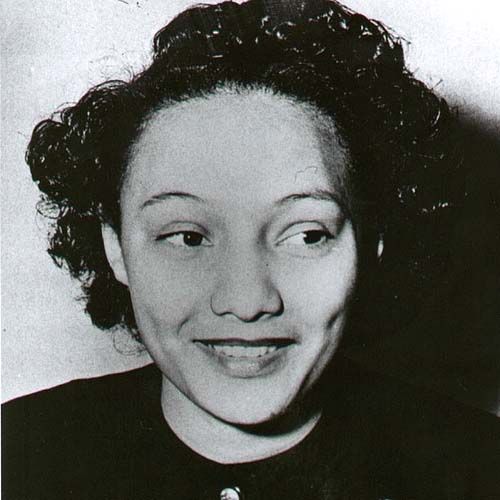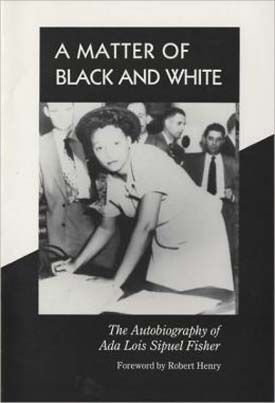Most of us are familiar with Brown v. Board of Education, a class action suit, with Oliver Brown as the named plaintiff, which ended with a landmark decision by the Supreme Court in which the Warren Court, in 1954, declared unanimously that state laws establishing separate public schools for black and white students were unconstitutional.
Many of us are not aware of the history of a decision that led up to Brown, Sipuel v. Board of Regents of Univ. of Okla.
In this case, the plaintiff, Ada Lois Sipuel Fisher, pictured above, was handed a victory, and was allowed to enter law school in Oklahoma.
You will note familiar names involved with her case:
The petitioners, acting on behalf of Miss Sipuel, were Thurgood Marshall of New York City, and Amos Hall, of Tulsa (also on the brief Frank D. Reeves). The respondents, representing the defendants, the university and the State of Oklahoma, were Fred Hansen, of Oklahoma City, the First Assistant Attorney General of Oklahoma, and Maurice H. Merrill, of Norman (also on the brief Mac Q. Williamson, Attorney General). This was a landmark case in the early civil rights movement. The case reversed Lee v. State of Mississippi, and was also a precursor for Brown v. Board of Education – 347 U.S. 483 (1954).
According to Supreme Court Associate Justice John Paul Stevens, who sat in the gallery and watched Marshall argue the case before the court on Thursday, January 8, 1948, Marshall was: “respectful, forceful and persuasive – so persuasive that on the following Monday – only four days after the argument – the Court unanimously ruled in Sipuel’s favor.” In addition, Ada Sipuel was: “not only an excellent student, but was welcomed by her classmates who did not agree with the exclusionary policy that the State had unsuccessfully tried to defend.”
Today is the anniversary, of the date, June 18, 1949, when she was granted admission after having been barred-twice.
As a young child, when I heard “Oklahoma” I simply thought of the Broadway show by that name. a state peopled by white folks dancing in fields of wheat as the wind came sweeping down the plains. It wasn’t until I got older, that I learned about the states racial history, in respect to both Native Americans, and its black population. I wrote about the 1921 Tulsa Massacre and the Destruction of Black Wall Street, here. Oklahoma had a full set of Jim Crow laws, with 18 on the books between 1890 and 1957.
Just who was Ada Lois Sipuel Fisher?
From Chickasha, Oklahoma she was the daughter of a minister. Her brother planned to challenge segregationist policies of the University of Oklahoma, but went to Howard University Law School to not delay his career further by protracted litigation. Sipuel was willing to delay her legal career in order to challenge segregation. In 1946, she applied at the University of Oklahoma and was denied because of race, and in 1948, the Supreme Court ruled that the state of Oklahoma must provide instruction for Blacks equal to that of whites.
In order to comply, the state of Oklahoma created the Langston University School of Law, located at the state capital. Further litigation was necessary to prove that this law school was inferior to the University of Oklahoma law school. Finally, in 1949, Sipuel was admitted to the University of Oklahoma law school becoming the first African American woman to attend an all white law school in the South. By this time she was married and pregnant with the first of her two children. The law school gave her a chair marked “colored,” and roped it off from the rest of the class. Her classmates and teachers welcomed her, shared their notes and studied with her, helping her to catch up on the materials she had missed.
Sipuel had to eat in a separate chained-off guarded area of the law school cafeteria. She recalled that years later some white students would crawl under the chain and eat with her when the guards were not around. Her lawsuit and tuition were supported by hundreds of small donations, and she believed she owed it to those donors to make it. She graduated in 1951 with a Master’s degree, and began practicing law in her hometown of Chickasha in 1952.
Fisher died October 18, 1995 after a long career as an educator.
In August 1952 Fisher graduated from the University of Oklahoma College of Law. She earned a master’s degree in history from the University of Oklahoma in 1968. After briefly practicing law in Chickasha, Fisher joined the faculty of Langston University in 1957 where she served as chair of the Department of Social Sciences. She retired in December 1987 as assistant vice president for academic affairs. In 1991 the University of Oklahoma awarded Fisher an honorary doctorate of humane letters.
Towards the end of her life, she had more to do with the University of Oklahoma.
On April 22, 1992, Gov. David Walters symbolically righted the wrongs of the past by appointing Dr. Ada Lois Sipuel Fisher to the Board of Regents of the University of Oklahoma, the same school that had once refused to admit her to its College of Law. As the governor said during the ceremony, it was a “completed cycle.” The lady who was once rejected by the university was now a member of its governing board.
This tribute to her was produced at the University of Oklahoma College of Law, where she was inducted (in memoriam) into OU Law’s Order of the Owl Hall of Fame on Nov. 8, 2011.
For further reading, I suggest, A Matter of Black and White: The Autobiography of Ada Lois Sipuel Fisher
This history, of the battle against racism, and an ultimate victory in the nation’s highest court, should serve also as a reminder of the power of SCOTUS, and why we need a court willing to decide fairly for the rights of the disenfranchised.
Crossposted to Black Kos


19 comments